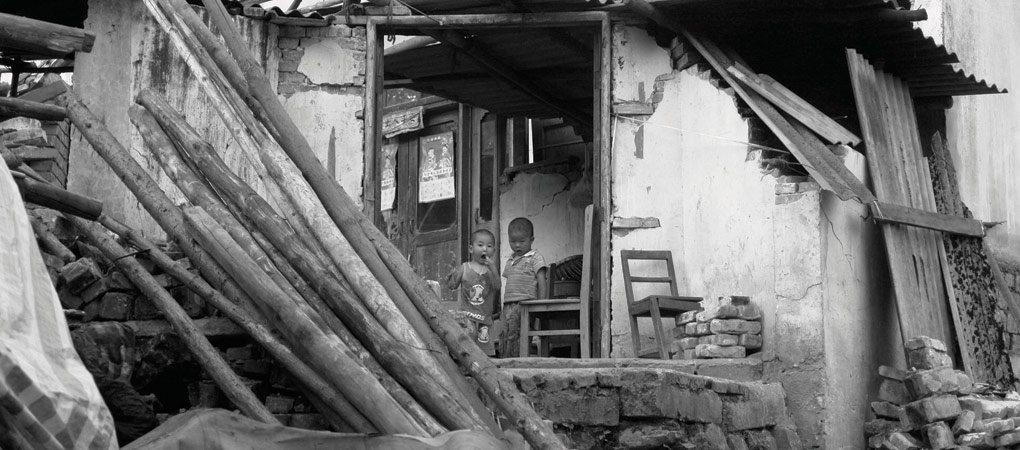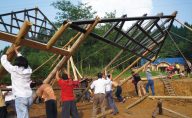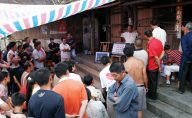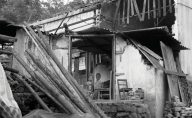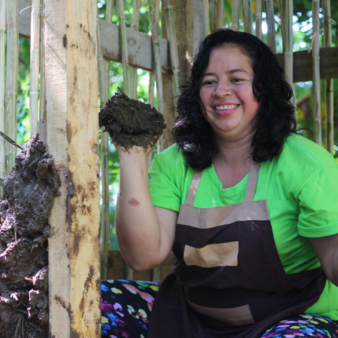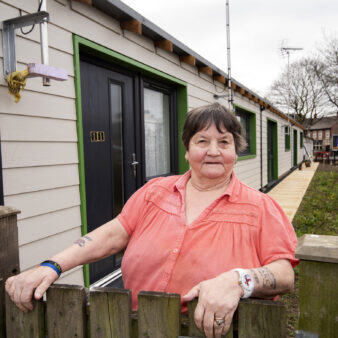Following the 2008 Wenchuan Earthquake, the Da Ping Village in the Sichuan Province of China was rebuilt with the support of the Green Building Research Centre (GBRC). The project aimed to create a harmonious village through socially and environmentally sustainable approaches to improve housing and infrastructure, economic conditions, sanitation and livelihoods. The entire village, including more than 200 houses and 11 public buildings, was reconstructed using traditional construction methods and environmentally sustainable materials and design. Local residents were engaged throughout the process, and a village organisation process has been established to address long-term issues such as developing local green planting, ecological industry and continued village environmental management.
Project Description
Aims and Objectives
- To reconstruct the village, develop the local economy and bring greater harmony with the local environment using sustainable development principles.
- To create a harmonious village through socially and environmentally sustainable approaches to improve infrastructure, economic conditions, sanitation and livelihoods.
Context
With the influence of rapid urbanisation and higher living standards in large areas of western China, more and more traditional forms of construction for housing are being replaced with new building methods that incorporate clay bricks and concrete. These new methods cause significantly more pollution and use more energy than traditional methods native to the region. Farmland is being used for building projects. Housing is typically of inferior quality, with poor natural lighting and environmental performance. The high relative humidity both indoors and outdoors causes problems with condensation on the floor and furniture. Brick masonry structure, constructed by householders who tried to imitate urban dwellings, are not seismic resistant. Sichuan is China’s rice bowl, but despite the abundance of food, it remains a poor part of China with many of its working population having moved away for work, leaving the poor and elderly behind.
The Wenchuan Earthquake measuring 8.0 on the Richter Scale struck China on 12th May 2008, causing extensive damage and killing 70,000 people. Da Ping Village stands at 1,600m, less than 30km away from the earthquake’s epicentre. Virtually all houses in the village were badly damaged or collapsed in the earthquake. Roads and bridges were completely destroyed. Only one life was lost, since the earthquake occurred when many people were working in the fields. Earning a living in the devastated town became impossible. Temporary housing provided after the earthquake is inappropriate, but many are still living in it due to the rapid increase in construction material costs.
Key features
Situated on the same site as the original settlement that was destroyed by the earthquake, more than 200 houses and 11 public buildings have been completed using environmentally sustainable materials and design. A five-stage process was used by GBRC, with in-depth analysis of local conditions and consultation with residents prior to design and development, followed by post occupancy surveys, including resident satisfaction surveys and monitoring of energy consumption.
Each family has a private house with an average living area of 35m2 per person with several different layouts possible using a modular design system. Houses were built on the original plots of the villagers and vary in size according to household size and wealth. The living spaces and courtyards reflect the local lifestyle and preferences of the residents. The building design and construction follow environmentally sustainable concepts for reducing energy consumption, including an innovative wall technology. Construction is based on a local timber-framed method (ChuanDou) which the villagers are well used to building and maintaining. The main building materials were wood and bamboo, locally rich in supply. All reusable materials from the damaged buildings on the site were salvaged and reused. Local residents were engaged in construction and were supervised by qualified engineers. Costs were less than US$76/m2 and these were met, half by the residents and half by the municipality and international aid. Seventy per cent of residents raised their half from their own savings and those who could not afford to do so were given interest-free loans from the government.
In addition to housing, the project has established a village organisation process in order to address long-term issues such as developing local green planting, ecological industry and continued village environmental management. Eco-business elements include diverse organic agricultural production as well as a village tourist and handicraft industry. The community maps the general production plan, manages the marketing and ensures food security and commercialisation. Community decision-making processes contribute greatly to a sense of cooperation and respect within the neighbourhood. A 610m2 community centre, including a reading room, chess room, meeting room and activity area for 200 people was built for gatherings, workshops and special events. Training classes are provided in the centre, with the result that the village has its own agriculture skilled teams, construction teams and medical treatment teams, all comprised of members of local families.
Covering costs
Fifty per cent of the population earns less than US$1,050 per annum, so low cost construction was not an option, but a necessity. The average house cost was less than US$76 per m2 and with a typical size of 35m2 per person typical house prices ranged from US$7,980 for a three-person household to US$13,330 for a five-person household. This compares to US$150 per m2 to 180 per m2 for normal construction and is significantly lower because the villagers used their own labour and local timber as well as salvaging materials.
Costs were met from a combination of residents’ savings, and grant aid from the Red Cross as well as the local government. Financial support from the government was allocated according to the size of each household, each of which received capital support ranging from US$2,426 to US$2,882. The Chinese Red Cross Foundation funded US$736 per person. Overall, donations from the Red Cross and the government accounted for half of the total cost, the villagers self-contribution accounted for the other half. GBRC, together with its partner the Global Village of Beijing met their own costs. The Red Cross funded the construction of the community facilities.
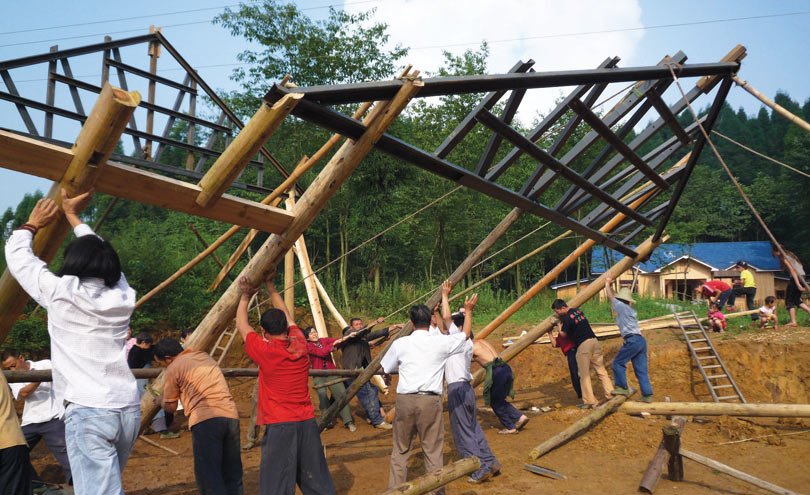
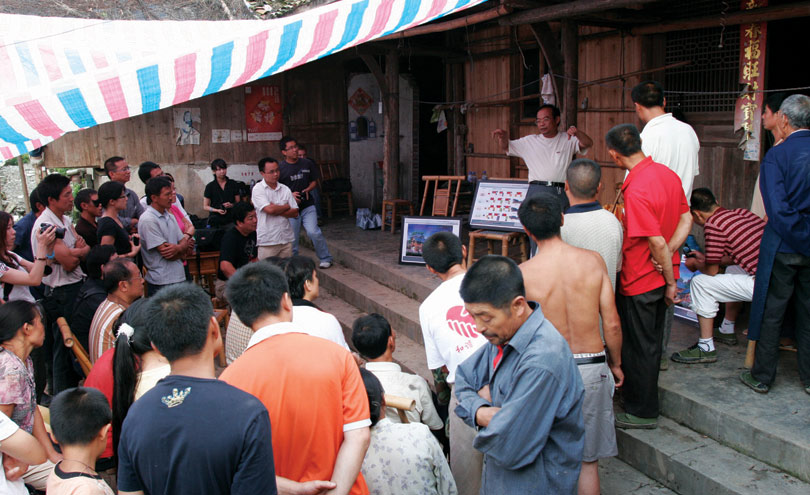
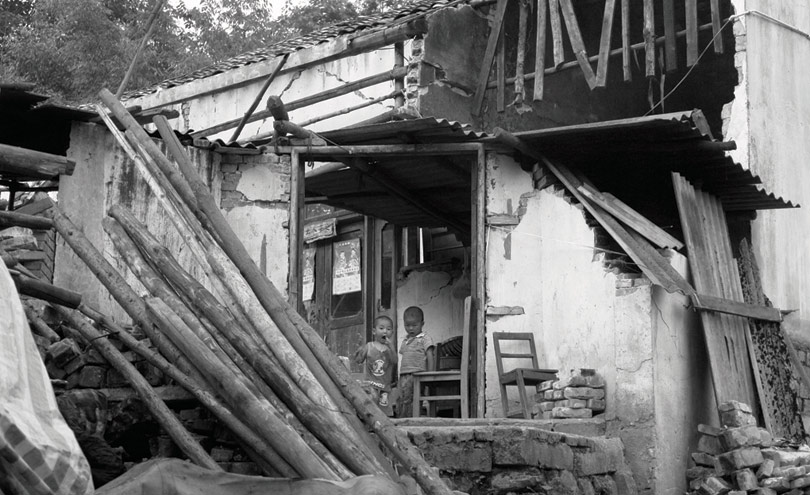
Impact
- The new houses provide more attractive living places, with improved indoor comfort environment for the residents.
- The publicity surrounding the village and its pioneering approach has brought many visitors to the area and raised the profile of environmentally sustainable housing both locally and nationally.
Why is it innovative?
- The creation of an overall ecological village master plan developed on sustainable design principles.
- The project not only retains the traditional way of life, it also spurs development of the local economy by harnessing local resources in an environmentally sensitive manner.
- A village environment management system has been established, with the villagers responsible for its management.
- Use of an ecological building design, which is compatible with the local climate and naturally conserves energy.
- Core house and module concepts are used to enable flexible design options. Once the core house is finished, spaces can be added as needed for further living requirements.
What is the environmental impact?
- Brick, wood and any other available material from the ruins of the houses after the earthquake were deliberately used for construction material, so as to reduce the construction and transport expense.
- Locally-grown timber and bamboo are used in construction, as well as other local materials such as earth and stone. For example, the popular bamboo fence wall, which not only retained the local vernacular tactile features but also achieved a much better thermal performance and well as sound insulation, and carbon dioxide emission reductions.
- Fifty per cent of all energy used comes from renewable sources, with the remainder being electric lighting and fuel wood for cooking
- Carbon dioxide emissions have been reduced with careful design throughout all the stages of the project; care was taken to attend to the smart use of local or recycled material and labour, natural ventilation and lighting and renewable energy, resulting in the smallest possible environmental footprint.
- Bio-gas production from human, animal and agricultural residue provides energy for cooking, lighting and heating.
- Increasingly scarce fertile land is preserved and the natural environment conserved.
- An agricultural eco-park provides an opportunity for information to be provided on organic agricultural methods.
- Energy saving cooking stoves, mash gas tanks and sewage pools help the community to live in harmony with nature.
Is it financially sustainable?
- The project is completed and so does not rely on future funding streams to continue its development.
- More varied and organic agriculture production, as well as a tourist village and handicraft industry have helped to boost incomes in the village. A village clinic and Chinese traditional health preservation centre has been built attracting tourists who are interested in Chinese traditional treatments, thereby developing the existing agricultural products.
- The community works as the bridge between the village and city on purchase and sale of agricultural and other products, increasing the income of local farmers while decreasing the commercial risk.
- Low-energy housing significantly reduces households’ fuel bills.
- The use of simple construction technologies has enabled villagers to help their neighbours build their own houses, as well as those in neighbouring villagers.
What is the social impact?
- All of the houses, including eleven public buildings, were built by the community through a self-help and mutual-help process, which has included training by qualified engineers.
- Villagers are responsible for the ongoing management and maintenance of the buildings and environment and have established an Environmental Association to coordinate these activities.
- GBRC team members trained local engineers, who then undertook the guidance and supervision of the construction of new houses, including teaching the basics of building construction and maintenance, often working alongside local residents.
- Rural doctors educate villagers on health care and hygiene practices. Agricultural technicians bought advanced biotechnology to help villagers improve the local soil, teaching them organic agriculture and modern farming methods.
- Hygiene was improved by distancing human dwelling areas from livestock areas; by separating designated livestock areas from, for instance, sanitary areas used by villagers.
- Potable water is made available by storage of mountain spring water using a simple filtering system. Care is taken to design the overall water environment such that potable water is separated from sewage and dark water.
- The Environmental Association has been established to provide an effective mechanism for villager participation and sharing of information.
- All of the village enterprises are community led and managed. The community sets the general production plan, manages the marketing and ensures food security and commercialisation.
- Community decision-making processes being well established, the project contributes greatly to a sense of cooperation and respect within the neighbourhood.
Barriers
At the initial stage of construction, few villagers had any awareness of energy efficiency, low carbon emission, or environmental protection and rejected the use of traditional structure and materials. Even during the process, there was some lingering doubt about the accessibility and operation of the ecological buildings. (Designers were familiarised with the traditional architecture and the way of life in the region, so the initial designs could blend the traditional with the modern).
Lack of involvement of local people in the post–earthquake situation. (Intensive on-site training helped establish a growing sense of new home ownership and identity, as well as re-directing the villagers’ attention away from the enormous losses of property and loved ones).
Because of the critical need (low incomes and high demand for affordable housing in Da Ping Village); it was necessary to ensure that the houses would be affordable for families at the lower end of the economic spectrum.
The source of villagers’ income solely depended upon the growing of a Chinese medicine ‘coptis’, which has a long growth cycle, with one crop every four years. (Addressed by developing alternative means of income generation).
Lessons Learned
- In post-disaster projects, priorities should be given to the supply of temporary shelter as well as permanent dwellings for the villagers, which would be crucial for further rehabilitation such as education and income regeneration.
- The initial fast-built demonstration units are essential in winning over local residents to new design ideas. The initial 44 units helped to resolve any conflict and the prevailing doubts among the villagers.
- Intense involvement of the local villagers was crucial to the success of the project.
- The module concepts with endless possibilities of free combinations can meet the demands of a variety of specific families.
- A subtle balance between architectural form and thermal performance should be sought when it comes to local material selection.
- The use of low technology solutions makes self-help and mutual help possible, encouraging a sense of ownership and identity, as well as facilitating transfer to nearby villages.
- There needs to be a balance between social acceptance and architectural performance, so that the cost, architectural form and comfort are easily acceptable by the occupants.
Evaluation
- GBRC monitors the energy consumption in the houses.
- The Village Deputy Committee supervises and manages cost control.
- GBRC will continue its monitoring for three years.
Transfer
Plans and construction drawings have been sent out to those who requested them following the TV coverage of GBRC’s work. Technically, the ecological techniques applied in the project have drawn great attention from a number of professionals in the field, spurring much discussion and interchange.
Residents from nearby villages have visited, learned from and emulated the demonstration project in Da Ping.
The methods developed in Da Ping Village were also used in Yushu County, Qinghai Province (120 homes provided in seven months), when an earthquake struck in 2010.
The methods were also used in constructing new nomadic accommodation for Tibetan herdsmen in Gangcha County, Qinghai Province (100 homes).
Ecological houses have been built using the same principles in Yinchuan City, Ningxia Province, in the northwest desert region (80 homes).
A further 200 homes are planned in Wuxi County, Chongqing Municipality.
A commercial developer is looking at the possibilities of replication near Xi’an.
Partnership
Academic/Research, Local community

